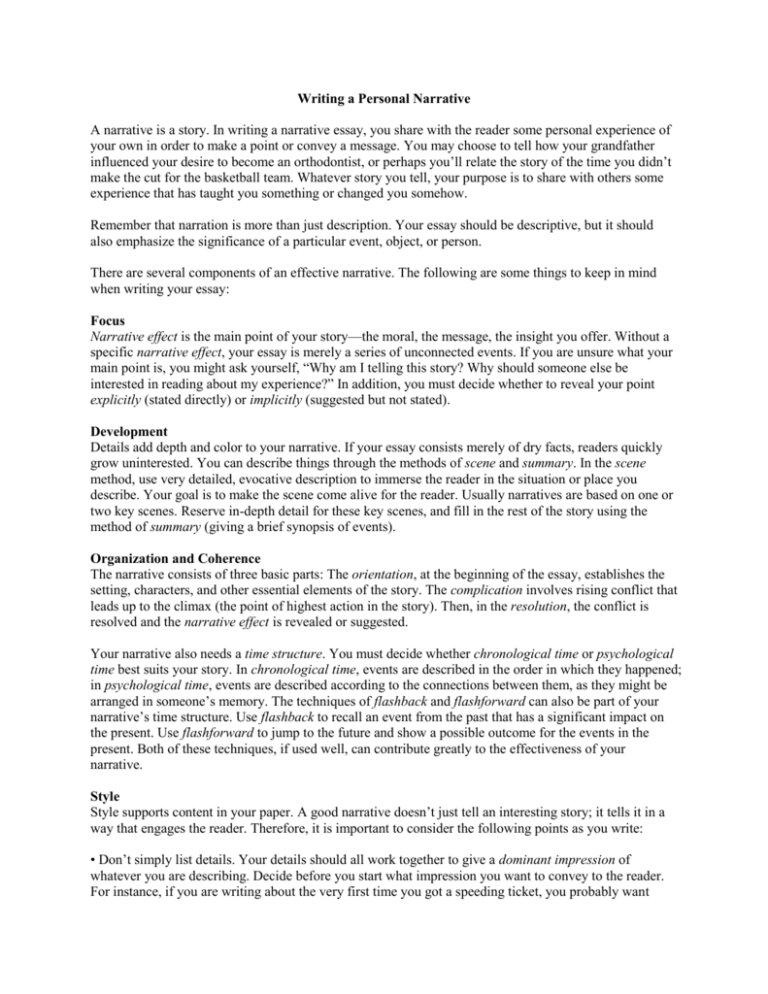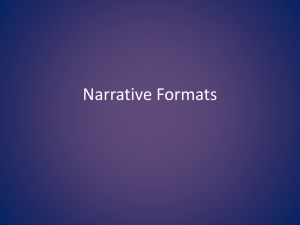
Writing a Personal Narrative
A narrative is a story. In writing a narrative essay, you share with the reader some personal experience of
your own in order to make a point or convey a message. You may choose to tell how your grandfather
influenced your desire to become an orthodontist, or perhaps you’ll relate the story of the time you didn’t
make the cut for the basketball team. Whatever story you tell, your purpose is to share with others some
experience that has taught you something or changed you somehow.
Remember that narration is more than just description. Your essay should be descriptive, but it should
also emphasize the significance of a particular event, object, or person.
There are several components of an effective narrative. The following are some things to keep in mind
when writing your essay:
Focus
Narrative effect is the main point of your story—the moral, the message, the insight you offer. Without a
specific narrative effect, your essay is merely a series of unconnected events. If you are unsure what your
main point is, you might ask yourself, “Why am I telling this story? Why should someone else be
interested in reading about my experience?” In addition, you must decide whether to reveal your point
explicitly (stated directly) or implicitly (suggested but not stated).
Development
Details add depth and color to your narrative. If your essay consists merely of dry facts, readers quickly
grow uninterested. You can describe things through the methods of scene and summary. In the scene
method, use very detailed, evocative description to immerse the reader in the situation or place you
describe. Your goal is to make the scene come alive for the reader. Usually narratives are based on one or
two key scenes. Reserve in-depth detail for these key scenes, and fill in the rest of the story using the
method of summary (giving a brief synopsis of events).
Organization and Coherence
The narrative consists of three basic parts: The orientation, at the beginning of the essay, establishes the
setting, characters, and other essential elements of the story. The complication involves rising conflict that
leads up to the climax (the point of highest action in the story). Then, in the resolution, the conflict is
resolved and the narrative effect is revealed or suggested.
Your narrative also needs a time structure. You must decide whether chronological time or psychological
time best suits your story. In chronological time, events are described in the order in which they happened;
in psychological time, events are described according to the connections between them, as they might be
arranged in someone’s memory. The techniques of flashback and flashforward can also be part of your
narrative’s time structure. Use flashback to recall an event from the past that has a significant impact on
the present. Use flashforward to jump to the future and show a possible outcome for the events in the
present. Both of these techniques, if used well, can contribute greatly to the effectiveness of your
narrative.
Style
Style supports content in your paper. A good narrative doesn’t just tell an interesting story; it tells it in a
way that engages the reader. Therefore, it is important to consider the following points as you write:
• Don’t simply list details. Your details should all work together to give a dominant impression of
whatever you are describing. Decide before you start what impression you want to convey to the reader.
For instance, if you are writing about the very first time you got a speeding ticket, you probably want
your reader to get an impression of fear, anxiety, and possibly guilt. Focusing on this impression, like
narrative effect, gives your essay purpose.
• The language you use is very important. First, use concrete nouns and active verbs. Don’t put your
reader to sleep by getting caught up in wordy sentences and vague descriptions. This means that you
should favor “blue, 1989 Honda Civic” over “car,” as an example, and strong, active verbs over weak
ones, as in the following examples:
Weak (form of be):
Weak (passive
voice):
Better (active voice):
A dog in the road was the cause of the 1989 Honda Civic hitting the school
bus.
The school bus was hit by the 1989 Honda Civic as the car swerved to miss a
dog in the road.
The 1989 Honda Civic swerved to miss a dog in the road and hit the school
bus.
In other words, use clear, precise language that keeps your reader’s attention. Also make use of sensory
language (language that appeals to the senses), especially when you are writing a highly detailed scene.
Don’t just tell us that spring was in the air—describe how the sun felt on your skin, how the birds sang
in the trees, how the dew sparkled on the grass. Make the reader see, smell, hear, feel, and taste the
scene you’re writing.
Finally, use appropriate metaphors and similes. Figurative language can add to your narrative by
suggesting to your reader how you felt in a particular situation. For example, to say that the police
officer who gave you that first ticket was “really tall” doesn’t convey the sense of terror you felt as well
as “he towered over me like Mt. Everest.” Metaphors and similes can be very helpful in revealing your
narrative effect to the reader.
• Decide which point of view, first-person or third-person, works best for your narrative. Most personal
narratives are written in first-person, but third-person can be effective as well. First-person tends to be
more subjective, but using both objective and subjective description appropriately is important with either
point of view. When describing something objectively, leave out your feelings about the subject. For
example, you might describe a house as “old,” “dark,” or “tall” to present a literal picture of the house to
the reader. In subjective description, emphasize your feelings toward the subject, which usually involves
stronger, more vivid language. The same house might now be “decaying,” “grim,” and “foreboding.” An
effective narrative will probably use both types of description.
• Use artistic license sparingly. You may need to exaggerate certain details to get your point across, but
remember that you are writing an academic essay, rather than fiction. Your narrative must be grounded in
reality.
Throughout our lives, we learn things from our experiences. What’s more, we can learn from the shared
experiences of others, and this is the purpose of a narrative essay. To help others benefit from our
knowledge, however, we must present it in an understandable format, which means paying attention to
focus, development, organization, coherence, and style. This may seem like an intimidating task, but
taken one at a time, these elements are manageable. Use this handout as a guideline while you write and
as a checklist afterward. Happy writing!
Copyright © Tacoma Community College Writing Center. All rights reserved.








